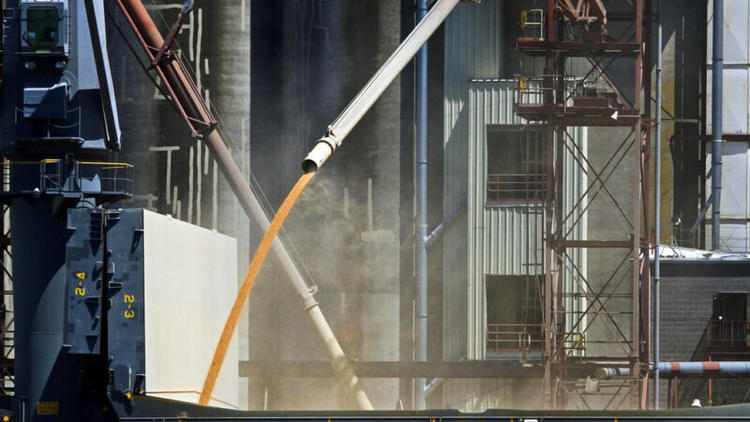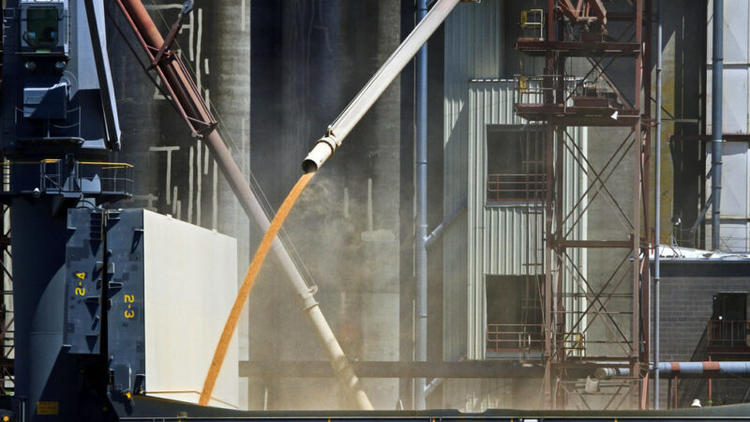By Roman Shemakov | –
Russia and Ukraine are two of the most essential pillars of the global food trade, producing 25 percent of the global wheat supply. More than 160 days after Russia invaded Ukraine, food, commodity, and energy shortages have plunged many economies across the world into recessions, particularly in the Middle East, where some countries are among the world’s largest importers of these commodities.
On average, Ukraine harvested 80 million metric tons of grain annually (wheat, corn, barley). This is enough to feed 200 million people for a year. The Russian invasion has reduced the harvest to less than half of its grain capacity. The naval blockade of the Black Sea has meant that much of Ukraine’s grain could not leave the port. In March, food prices reached a 10-year high and the United Nations warned of multiple famines within the next year.
“A Crop Of Grain” by Ian Sane licensed under CC BY 2.0.
After months of negotiations, on August 1, a ship carrying 26,000 tons of grain left the port of Odessa; the first ship to do so since the start of the war. The agreement reached on July 22 in Istanbul between Ukraine and Russia guarantees continuous passage of grain out of Ukraine. This especially a good sign for countries throughout the Middle East and North Africa, where many states import more than 80 percent of their national grain supply from Ukraine, and are most vulnerable to rising food prices.
But free shipping routes will not abate the growing food crisis. Russian destruction of farmland and heavy machinery has caused more than USD 4.3 billion in damages to the agricultural industry. More than 6 million poultry birds have died and half a billion USD worth of grain has been stolen. Some estimate more than half of Ukraine’s operable farmland is under occupation.
In a video interview with Global Voices, David Rundell, a thirty-year diplomat to the Middle East and author of “Vision or Mirage: Saudi Arabia at the Crossroads,” explained the distributed impact of the war on countries across the region: “There is very little interest across the Middle East for getting in the middle of a fight they don’t believe is theirs. There is much more concern about what impact the war will have on political stability. Many nations are seeing what happened in Sri Lanka and are concerned that similar events will transpire in their own neighborhood.”
This analysis is in line with broad attitude surveys across the Middle East and North Africa. In an Arab News-YouGov poll of the region, 66 percent of respondents had no stance on the war, 18 percent supported Ukraine and 16 percent supported Russia
Rundell emphasized the outsized impact of commodity shortages on the region: “many countries across the region are very sensitive to the price of wheat, sunflower seed oil, and petroleum. All of these have been adversely affected by shortages or rising global prices. At the moment, the various governments are trying to maintain the subsidies that they have and it is leading to huge budget deficits.”
Nearly every country in the region is hard hit by the war.
The war has inflicted unprecedented inflation shocks on the Egyptian economy. There is almost no tourism from Ukraine and Russia, which normally account for 30 percent of Egypt’s incoming visitors. The manufacturing and construction industries have been most affected due to energy and material prices increases. Egypt, which gets 80 percent of its wheat from Ukraine and Russia, has been forced to look to other countries for grain imports, and the cost of bread has increased by 50 percent since the start of the war. As a result, the Suez Canal raised toll fees and the central bank devalued the currency by 14 percent to support the struggling economy.
Food insecurity is expected to become even more acute in Yemen, which imports 40 percent of its wheat from Ukraine and Russia. The humanitarian crisis in the country that began with the civil war in 2015 is
Libya imports 90 percent of its wheat from Ukraine and Russia. Across the board, prices of bread, rice, and couscous have risen more than 30 percent. The war has added more than a percentage point to the country’s inflation pressures, bringing the overall rate to 9 percent.
Algeria is the most insulated from adverse impacts of the war. The country imports 3 percent of its wheat from Ukraine and Russia, and domestic supplies are sufficient to outlast shortages until the end of 2023.
Tunisia imports approximately 54 percent of its wheat from Ukraine and Russia. The country already owes USD 300 billion to Ukrainian wheat exporters. The worsening economic outlook, rising inflation, skyrocketing food prices, and a water crisis all have the potential to significantly destabilize the nation further.
More than
On July 19, Vladimir Putin visited Tehran as a sign of continuing stability in Russian–Iran relations. Now that both states are constrained by crippling global sanctions, both are competing for oil markets in Asia. The president of Iran’s Oil and Gas Exporters’ Union announced that sales to China had fallen by 34 percent since May. Similar pressures are impacting Iran’s USD 6 billion steel market. Russia remains a key signatory of the 2015 Join [AN: Joint?] Comprehensive Plan of Action (JCPOA) on limiting Iran’s nuclear proliferation; in March, Russian Foreign Minister Sergey Lavrov demanded that the United States ensure certain trade guarantees or it would refuse to support the deal.
The Iraqi government has refrained from taking a stance on the conflict, voting on an Arab League statement that did not assign blame to Russia and abstaining from the UN condemnation of Russian aggression. Russia has more than USD 14 billion invested in Iraqi oil and gas sectors, and Iraq purchases billions of Russian weapons annually. Iraq does not purchase Russian or Ukrainian agricultural products, but the nation imports 50 percent of all food and has been adversely affected by rising food prices. On June 8, the
Approximately 90 percent of the West Bank and Gaza’s food supply is imported. More than a third of the national reliance is on Ukrainian wheat. A manager of a flour mill in Gaza noted, that the primary cause of rising food prices “…is the Russian–Ukraine war. We had stores for two to three months, but when they ran out we were obliged to buy wheat at new prices, and it was very high.” Lack of effective agricultural infrastructure, control over irrigation resources, and a financial crisis is likely to exacerbate the pressure on food supplies.
The government of Israel has been hesitant to support Ukraine unequivocally. Russia’s presence in Syria and Iran — both existential threats to the nation — has drawn Israel closer to Moscow. As a result, Israel has not provided Ukraine with military aid or joined in Western sanctions against Russia. A large majority of Israelis support Ukrainians in the war.
The rise in energy prices has been a financial bonanza for oil-exporting countries throughout the Gulf. A significant portion of the income has been directed to food security ministries and projects. Western solidarity in opposition to the war has been met with cool responses throughout the region, which maintains close alliance with both Russia and China. In a meeting with all the Gulf sheikdoms in Jeddah, Saudi Arabia, Biden noted “We will not walk away and leave a vacuum to be filled by China, Russia or Iran, and we’ll seek to build on this moment with active, principled American leadership.”
Rundell concludes, “the inevitable result of collapsing economies and political unrest in the Middle East and Africa will be massive, illegal migration into Europe on a scale far greater than the previous war-related emigration from Syria and Libya. Preventing that outcome will require immediate, large scale, well coordinated, multinational action. It will require far more than a token increase in foreign aid that will merely bid up the price of existing wheat supplies.”
For more information about this topic, see our special coverage Russia invades Ukraine.
Written byRoman Shemakov




 © 2025 All Rights Reserved
© 2025 All Rights Reserved